INTRODUCTION
Among the diverse sources of stem cells that hold immense regenerative potential, dental stem cells (DSCs) have gained significant attention from researchers. These unique cells, found within the dental tissues of deciduous and permanent teeth, present a non-invasive and readily accessible source for stem cell isolation.
Dental pulp stem cells (DPSCs) were described by Gronthos et al. [1]. In addition to DPSCs and stem cells from human exfoliated deciduous teeth, several other distinct stem cell populations have been reported to reside within the human tooth and its surrounding tissues—stem cells from the apical papilla [2], the dental follicle [3] and the periodontal ligament [4,5]. According to the minimal criteria defined by the International Society for Cellular Therapy, all the stem cells mentioned above, collectively called DSCs, are considered mesenchymal stem cells (MSCs). These cells can undergo osteogenic, chondrogenic, and adipogenic differentiation [6–8]. In addition, these can also differentiate into myogenic, neurogenic, and endothelial lineages. Due to this multilineage differentiation potential and immunomodulatory properties, these cells offer promising therapies, tissue engineering, regenerating missing or damaged dental tissues, and even treating systemic disorders beyond oral health [9,10]. DPSCs have a broad range of applications as a regenerative material; they can repair mandibular bone defects [11] as well as they could be differentiated into pancreatic cell lineage [12]. Thus, DSCs are interesting and potentially essential cells ready for therapeutic regenerative purposes [13]. Although stem/progenitor cells have been isolated from different tissues and extensively studied in vitro and in vivo in the past years [14–16], a bibliometric study would clarify the transition in research and current research trends.
A few bibliographic analyses have been done on this topic, but they mainly included either the most cited papers or included studies done over two decades. In this bibliometric analysis and visualization, we delve into the global research trends related to DSCs since their inception, shedding light on the progression of this dynamic and evolving domain. By employing bibliometric techniques, we aim to quantify and map the scientific output, identify influential research clusters and collaborations, and discern the emerging hotspots in the field.
The objective of this study is to provide a comprehensive overview of the research landscape surrounding DSCs, elucidating the key contributors, institutions, and countries driving the advancements, discern the thematic evolution of research topics, and pinpoint critical inflection points that have shaped the trajectory of DSC research.
MATERIALS AND METHODS
An online electronic search was performed on 24 July 2023 in the PubMed database to identify the research done on DSCs. The search strategy used was -(Stem cells) AND (Dental pulp OR periodontal ligament OR deciduous teeth OR apical papilla OR dental follicle stem cells). All articles were included review articles, clinical trials, meta-analyses, and book chapters. We did not apply any filter for species, language, gender, journal, age, or publication date. The flow chart of the study selection process was generated according to the Preferred Reporting Items for Systematic Reviews and Meta-Analyses (PRISMA) guidelines [17].
The data was exported to text files for subsequent analysis. Network analysis and visualization were done with the help of the VOSviewer software (version 1.6.18) and Biblioshiny. VOSviewer is a software tool for creating and visualizing maps based on network data [18]. Biblioshiny is a web-based app for comprehensive science mapping analysis [19].
The following aspects were analyzed:
(i) Research trends;
(ii) the most contributing authors;
(iii) the most frequently used keywords;
(iv) the leading organizations;
(v) the most contributing countries and their collaboration frequency;
(vi) most relevant journals; and
(vii) co-occurrences and link strengths among various authors and keywords related to DSC research.
RESULTS
A total of 6,685 results appeared from an online search in the PubMed database. Of these 34 clinical trials, 867 reviews and systematic reviews, 14 meta-analyses, 6 books and documents (Fig. 1).
Publishing trend of research papers on dental stem cells
The first publication on the topic was published in the year 1968. Till 2009 0nly, 479 papers were published. Figure 2 shows a gradual increase in the number of research papers during the last two decades, ranging from 6 papers in 2000 to 872 papers in 2022, with only a slight decrease in 2018.
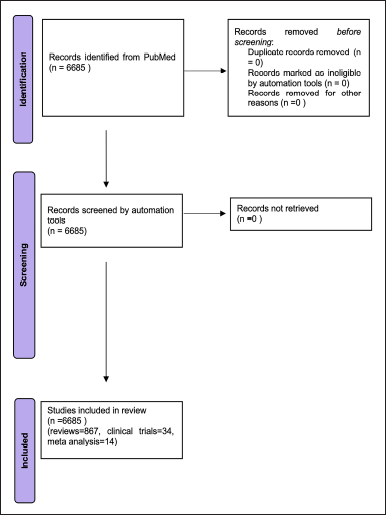 | Figure 1. A flow chart depicting the process of selection of studies. [Click here to view] |
 | Figure 2. The publishing trend of research papers on DSCs. [Click here to view] |
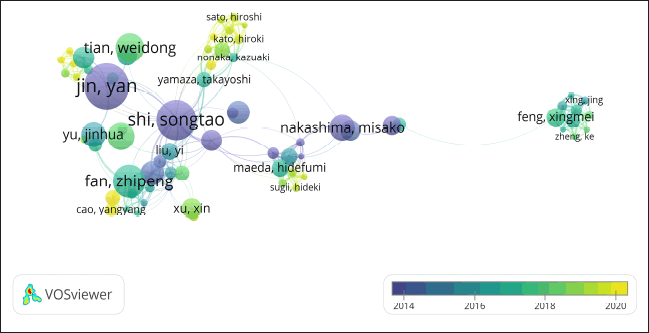 | Figure 3. Overlay visualization of co-authorship links in research papers on DSCs. The color bar indicates the year of publication based on the color of the circles. [Click here to view] |
Co-occurrence of authors and most relevant authors
A total of 17,045 authors were identified, of which 70 authors with a minimum of 10 documents and the highest link strength are represented in Figure 3. All authors from the same cluster are shown with the same color. The circle size represents the number of publications by the authors, and the line between the circles represents a link between the authors. The link color is consistent with the color of their source clusters. There are 10 clusters, 292 links, and 2,213 link strengths (Fig. 3). The green and yellow color represents the authors with the most recent publications.
The most relevant authors are listed in Figure 4. The top three most relevant authors in the field of DSCs are Wang Y, Zhang Y, and Liu Y, with 175, 171, and 166 papers, respectively. The ten most relevant authors published 1,297 research papers: the three contributed 39.5%.
Most relevant affiliations
The most relevant university related to research on DSCs is Sichuan University, with 1,666 Publications. It contributed more than one-fourth of the total papers (26.5%) published by all ten most relevant universities (i.e., 6,285). Fourth Military Medical University and Sun Yat-Sen University published 854 research papers each (Fig. 5).
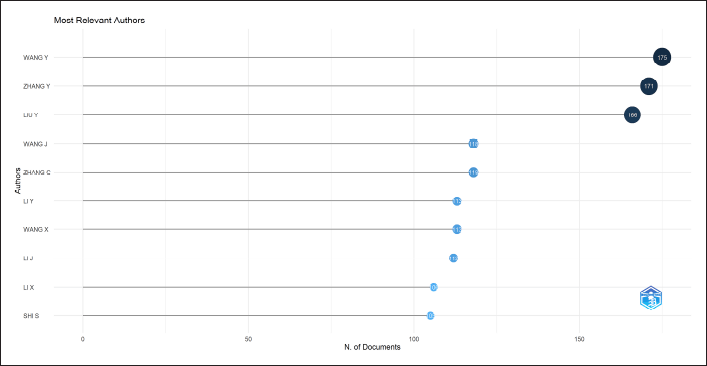 | Figure 4. Most relevant authors in the field of DSCs research. [Click here to view] |
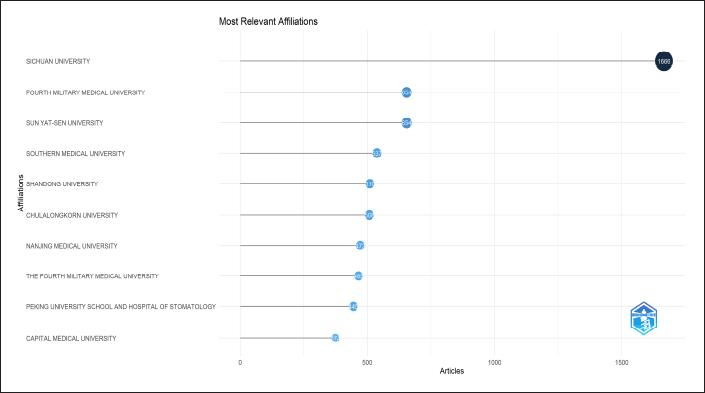 | Figure 5. Most contributing universities in the DSC research. [Click here to view] |
Most relevant sources
The most relevant source is the Journal of Endodontics, with 312 research papers on DSCs, and contributed to almost 20% of the papers published by all most relevant journals (i.e., 1,566). The other important sources are Stem Cell Research and Therapy and the Journal of Dental Research, with 177 and 176 research papers, respectively (Fig. 6).
Keywords analysis
The analysis yielded a total of 11,193 keywords, of which 895 keywords had a minimum occurrence of 10 and 516 had a minimum occurrence of 20. A total of 3,858 keywords were Medical Subject Headings (MeSH), of which 691 keywords had a minimum occurrence of 10 and 417 had a minimum occurrence of 20. Network analysis included 404 keywords linked with other keywords and identified 7 clusters, 35,181 links with 189,451 total link strength. The number of items ranges from 1 to 116 in various groups. Ten keywords not specific to DSC research were excluded from the analysis – animal, human, male, female, child, young, adolescent, rat, mice, and stem cells; so that more specific keywords could be identified more clearly in the network analysis. The keyword human was as high as 4,238, with a total link strength of 43,313. The keyword specified after removing the nonspecific terms with maximum occurrence is cell differentiation, cell proliferation, and osteogenesis (Fig. 7).
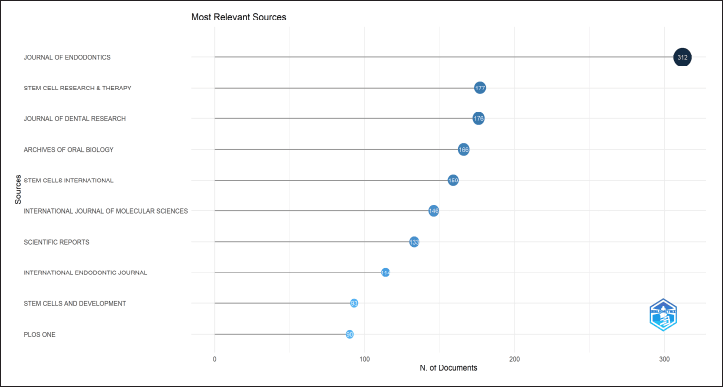 | Figure 6. Most relevant sources in the DSCs research. [Click here to view] |
Trend topic analysis and thematic evaluation
The trend topic analysis suggests that during the initial phase (2006–2012) of development, DSC research was focused on sialoproteins, sialoglycoprotein, bone morphogenic proteins, extracellular matrix protein, cytology, and physiology. Different themes emerged between 2012 and 2019, such as cell culture, cell differentiation, dental pulp, and cell proliferation. The most recent terms identified are genetics, osteogenesis, and periodontal ligament. Thus, the analysis indicates that the research was initially focused on the molecular level and proteins, whereas it now focuses more on dental pulp, bone, and periodontal ligament (Fig. 8). Thematic evolution analysis (Fig. 9) also highlights that the terms used before 2019 were cell differentiation, cell culture, alkaline phosphatase, physiology, and pharmacology. In contrast, terms used after 2019 were drug combinations, materials testing, and tissue engineering.
Three field plots
The three-field plot analysis indicates that most of the authors who published research papers on DSCs were from China, Japan, the USA, Italy, and Korea. The contribution from China is highest in publications on DSCs in all top five journals—Stem Cell Research and Therapy, Stem Cells International, Journal of Dental Research, Journal of Endodontics, and Archives of Oral Biology. Most of the research papers from Japan are published in Stem Cell Research and Therapy. Most of the articles from the USA are published in the Journal of Dental Research (Fig. 10).
Figure 11 shows that most of the research papers from all the countries are single-country publications. Very few publications are multiple-country publications. The maximum collaboration can be noted in authors of China, followed by the USA and Japan.
DISCUSSION
A gradual increase in the number of research papers during the last two decades, ranging from 6 papers in 2000 to 872 papers in 2022, was observed. A slight decrease was noted in 2018 (Fig. 2). The analysis identified China as the most productive country and the Journal of Endodontics as the most relevant source in this field. According to the analysis, cell differentiation is the keyword specific to the area with the highest co-occurrence. Sichuan University is identified as a top contributor with 1,666 publications on DSC research. Wang Y, Zhang Y, and Liu Y were identified as the most relevant authors, with 175, 171, and 166 papers. Most of the papers on DSCs are single-country publications. However, the collaboration frequency between China, Japan, and the United States of America is comparatively higher than in other countries. This analysis highlights the transition in research from sialoproteins to more application-based, such as tissue engineering and periodontal ligament.
Very few bibliometric studies have been published on DSCs research. A bibliometric analysis [20] performed using the web of sciences identified the United States as the most significant contributor of highly cited research papers, China as the most research papers, and the Journal of Endodontics as the most relevant source. The findings are in alignment with our study. The most used keywords were stem cells, MSCs, DPSCs, tissue engineering, bone regeneration, differentiation, and osteogenic differentiation. Our analysis yielded the same information despite being performed in different databases. However, the most contributing authors were others from our findings. This may be due to variations in the period selected. The study by Zhao et al. [20] included research papers from 2000 to 2022, whereas our study included all the articles since 1968 when the first report was identified. Another bibliometric analysis of the 100 most cited articles on DSCs [21] performed using the Scopus database also identified USA and China as significant contributors in this field. Another bibliometric analysis of the top 50 cited papers on DSCs was performed using the Web of Science database identified the Journal of Dental Research as the most relevant source and the USA, Japan, and China as the leading countries. The most common keywords identified were dental pulp, mesenchymal cells, and tissue engineering. The findings align with ours except for the most relevant source and authors [22]. The differences in results might be due to the variation in the period selected for analysis.
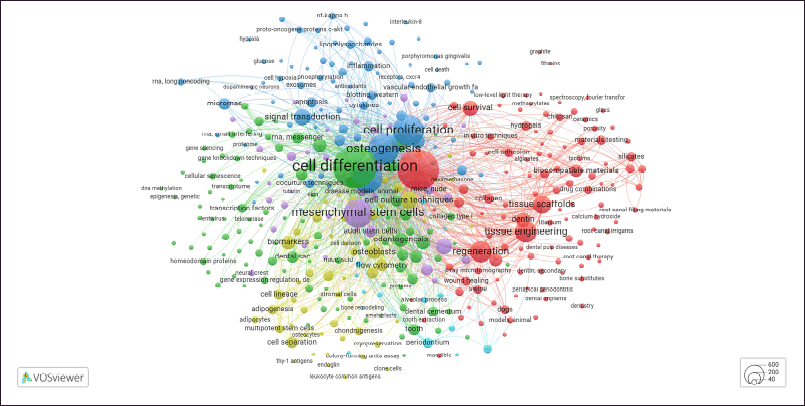 | Figure 7. Co-occurrence of keywords in DSC research. The bigger font size represents more frequently used keywords. [Click here to view] |
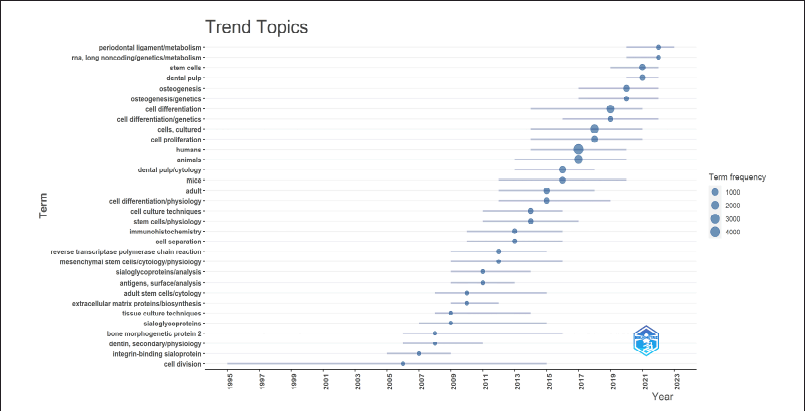 | Figure 8. Trend topic analysis of DSC research. [Click here to view] |
 | Figure 9. Thematic evolution analysis (by Biblioshiny). It identifies changes in terminology and evolution in study themes related to DSC research. [Click here to view] |
 | Figure 10. Three field plots. (AU = author, AU_CO = author’s country, SO = source; parameters selected—AU = 10, AU_CO = 5, and sources = 5). It represents the interrelations between various countries, sources of scientific articles, and their authors. [Click here to view] |
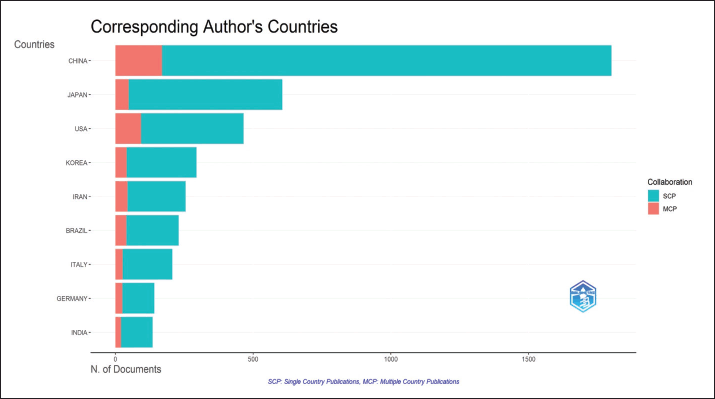 | Figure 11. Analysis of countries and their collaboration frequency. [Click here to view] |
Screening of articles by automated tools in our study eliminated the risk of subjective bias and allowed data analysis at a large scale. However, there are certain limitations too. The study’s main limitation is that only one database was considered for the analysis. Another limitation is that the citation analysis couldn’t be performed as data from the PubMed database doesn’t support this analysis. In bibliometric analysis, it is not possible to analyze each and every paper individually for any particular data, such as gene markers, method of extraction of stem cells, and method of stem cell preservation, due to the large number of articles included in the analysis. Systematic reviews are required to provide such in-depth analysis. Nevertheless, this study could aid in identifying research patterns and trends, leading researchers and organizations to new researchers.
CONCLUSION
A gradual increase in research papers during the last two decades was observed, with a slight decrease in 2018. The analysis identified China as the most productive country, Sichuan University as the most relevant University, and the Journal of Endodontics as the most appropriate source for DSC research. Cell differentiation is the most frequently used term for the field with the highest co-occurrence. Most of the papers on DSCs are single-country publications. However, the collaboration frequency between China, Japan, and the United States of America is comparatively higher than in other countries. This analysis highlights the transition in research from sialoproteins to more application-based, such as tissue engineering and periodontal ligament. This bibliometric analysis provides an overview of DSC research since its inception.
ACKNOWLEDGEMENT
The graphical abstract of this paper has been drawn with the premium version of BioRender (https://biorender.com/ accessed on August 10 2023) with license number FW25PPREPO. Image credit: Rahnuma Ahmad.
AUTHOR CONTRIBUTIONS
All authors made substantial contributions to the conception and design, acquisition of data, or analysis and interpretation of data; took part in drafting the article or revising it critically for important intellectual content; agreed to submit to the current journal; gave final approval of the version to be published; and agree to be accountable for all aspects of the work. All the authors are eligible to be an author as per the International Committee of Medical Journal Editors (ICMJE) requirements/guidelines.
FUNDING
There is no funding to report.
CONFLICTS OF INTEREST
The authors report no financial or any other conflicts of interest in this work.
ETHICAL APPROVALS
This study does not involve experiments on animals or human subjects.
DATA AVAILABILITY
All the data is available with the authors and shall be provided upon request.
PUBLISHER’S NOTE
This journal remains neutral with regard to jurisdictional claims in published institutional affiliation.
REFERENCES
1. Gronthos S, Mankani M, Brahim J, Robey PG, Shi S. Postnatal human dental pulp stem cells (DPSCs) in vitro and in vivo. Proc Natl Acad Sci USA. 2000;97(25):13625–30. CrossRef
2. Sonoyama W, Liu Y, Yamaza T, Tuan RS, Wang S, Shi S, et al. Characterization of the apical papilla and its residing stem cells from human immature permanent teeth: a pilot study. J Endod. 2008;34(2):166–71. CrossRef
3. Morsczeck C, Götz W, Schierholz J, Zeilhofer F, Kühn U, Möhl C, et al. Isolation of precursor cells (PCs) from human dental follicle of wisdom teeth. Matrix Biol. 2005;24(2):155–65. CrossRef
4. Seo BM, Miura M, Gronthos S, Bartold PM, Batouli S, Brahim J, et al. Investigation of multipotent postnatal stem cells from human periodontal ligament. Lancet. 2004;364(9429):149–55. CrossRef
5. Sedgley CM, Botero TM. Dental stem cells and their sources. Dental Clin. 2012;56(3):549–61.
6. Dominici M, Le Blanc K, Mueller I, Slaper-Cortenbach I, Marini F, Krause D, et al. Minimal criteria for defining multipotent mesenchymal stromal cells. The International Society for Cellular Therapy position statement. Cytotherapy. 2006;8(4):315–7. CrossRef
7. Gronthos S, Brahim J, Li W, Fisher LW, Cherman N, Boyde A, et al. Stem cell properties of human dental pulp stem cells. J Dent Res. 2002;81(8):531–5. CrossRef
8. Hilkens P, Gervois P, Fanton Y, Vanormelingen J, Martens W, Struys T, et al. Effect of isolation methodology on stem cell properties and multilineage differentiation potential of human dental pulp stem cells. Cell Tissue Res. 2013;353(1):65–78. CrossRef
9. Sui B, Hu C, Zhang X, Zhao P, He T, Zhou C, et al. Allogeneic mesenchymal stem cell therapy promotes osteoblastogenesis and prevents glucocorticoid-induced osteoporosis. Stem Cells Transl Med. 2016;5(9):1238–46. CrossRef
10. Khorsand A, Eslaminejad MB, Arabsolghar M, Paknejad M, Ghaedi B, Rokn AR, et al. Autologous dental pulp stem cells in regeneration of defect created in canine periodontal tissue. J Oral Implantol. 2013;39(4):433–43. CrossRef
11. d’Aquino R, De Rosa A, Lanza V, Tirino V, Laino L, Graziano A, et al. Human mandible bone defect repair by the grafting of dental pulp stem/progenitor cells and collagen sponge biocomplexes. Eur Cell Mater. 2009;18:75–83. CrossRef
12. Govindasamy V, Ronald VS, Abdullah AN, Nathan KR, Ab Aziz ZA, Abdullah M, et al. Differentiation of dental pulp stem cells into islet-like aggregates. J Dent Res. 2011;90(5):646–52. CrossRef
13. Chalisserry EP, Nam SY, Park SH, Anil S. Therapeutic potential of dental stem cells. J Tissue Eng. 2017;8:2041731417702531. CrossRef
14. Hilkens P, Fanton Y, Martens W, Gervois P, Struys T, Politis C, et al. Pro-angiogenic impact of dental stem cells in vitro and in vivo. Stem Cell Res. 2014;12(3):778–90. CrossRef
15. Lei M, Li K, Li B, Gao LN, Chen FM, Jin Y. Mesenchymal stem cell characteristics of dental pulp and periodontal ligament stem cells after in vivo transplantation. Biomaterials. 2014;35(24):6332–43.
16. Laing AG, Riffo-Vasquez Y, Sharif-Paghaleh E, Lombardi G, Sharpe PT. Immune modulation by apoptotic dental pulp stem cells in vivo. Immunotherapy. 2018;10(3):201–11.
17. Page MJ, McKenzie JE, Bossuyt PM, Boutron I, Hoffmann TC, Mulrow CD, et al. The PRISMA 2020 statement: an updated guideline for reporting systematic reviews. BMJ. 2021;372:n71. CrossRef
18. Van Eck NJ, Waltman L. VOSviewer manual. Leiden, Netherlands: Leiden University; 2022 [cited 2023 Aug 10]. Available from: https://www.vosviewer.com/documentation/Manual_VOSviewer_1.6.18.pdf
19. Aria M, Cuccurullo C. Bibliometric: an R-tool for comprehensive science mapping analysis. J Informetr. 2017;11(4):959–75. CrossRef
20. Zhao H, Liu JB, Bao ZF, Xu YX, Wang ZQ. Global research trends in dental stem cells: a bibliometric and visualized study. Tissue Eng Part B Rev. 2022;28(4):733–44. CrossRef
21. Sengupta N, Sarode SC, Viswanathan V, Sarode GS, Patil SS, Gadbail AR, et al. Bibliometric analysis of the 100 most cited articles on dental stem cells. World J Dent. 2020;11(4):274–83. CrossRef
22. Kodonas K, Fardi A, Gogos C, Economides N. Top 50 cited articles on dental stem cell research. Restor Dent Endod. 2020;45(2):e17. CrossRef